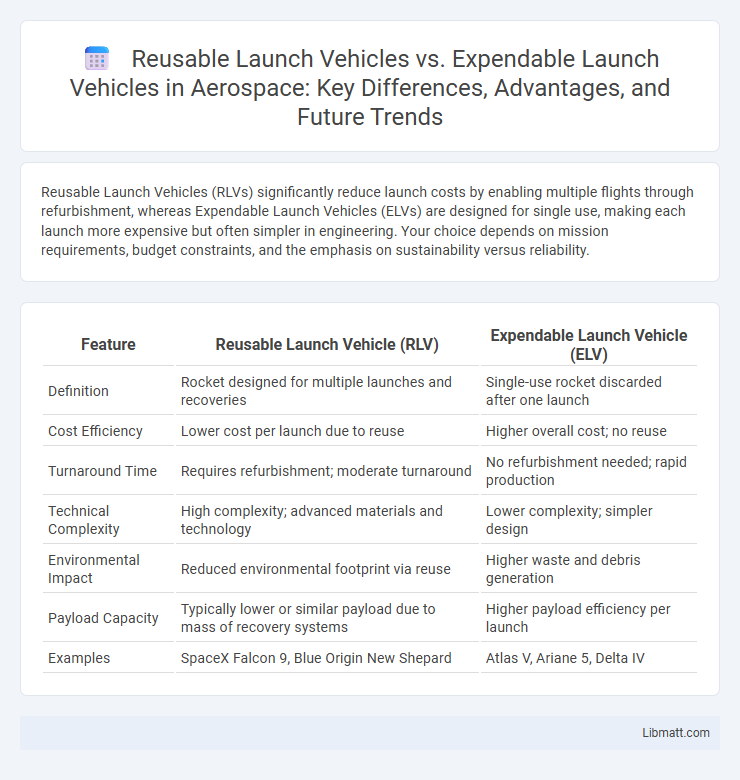Reusable Launch Vehicles (RLVs) significantly reduce launch costs by enabling multiple flights through refurbishment, whereas Expendable Launch Vehicles (ELVs) are designed for single use, making each launch more expensive but often simpler in engineering. Your choice depends on mission requirements, budget constraints, and the emphasis on sustainability versus reliability.
Table of Comparison
| Feature | Reusable Launch Vehicle (RLV) | Expendable Launch Vehicle (ELV) |
|---|---|---|
| Definition | Rocket designed for multiple launches and recoveries | Single-use rocket discarded after one launch |
| Cost Efficiency | Lower cost per launch due to reuse | Higher overall cost; no reuse |
| Turnaround Time | Requires refurbishment; moderate turnaround | No refurbishment needed; rapid production |
| Technical Complexity | High complexity; advanced materials and technology | Lower complexity; simpler design |
| Environmental Impact | Reduced environmental footprint via reuse | Higher waste and debris generation |
| Payload Capacity | Typically lower or similar payload due to mass of recovery systems | Higher payload efficiency per launch |
| Examples | SpaceX Falcon 9, Blue Origin New Shepard | Atlas V, Ariane 5, Delta IV |
Introduction to Launch Vehicle Types
Reusable Launch Vehicles (RLVs) are designed to return to Earth intact after delivering payloads, enabling multiple launches with reduced per-mission costs. Expendable Launch Vehicles (ELVs) are single-use rockets that are discarded after one flight, often resulting in higher costs per launch but simpler engineering. The choice between RLVs and ELVs depends on mission requirements, budget constraints, and advances in technology aimed at improving launch efficiency and sustainability.
Defining Reusable Launch Vehicles (RLVs)
Reusable Launch Vehicles (RLVs) are spacecraft designed to be launched, recovered, and relaunched multiple times, significantly reducing the cost of access to space. Unlike Expendable Launch Vehicles (ELVs), which are used once and then discarded, RLVs incorporate advanced materials and technologies for durability and repairability after each mission. Key examples of RLVs include SpaceX's Falcon 9 first stage and the Space Shuttle orbiter, highlighting their role in sustainable space exploration.
Understanding Expendable Launch Vehicles (ELVs)
Expendable Launch Vehicles (ELVs) are rockets designed for a single-use mission, where all components are discarded after launch, making them cost-intensive compared to reusable options. ELVs are typically favored for heavy payloads or missions requiring maximum reliability, as their design prioritizes performance without the need for recovery systems. Understanding ELVs helps in evaluating launch costs, mission requirements, and the trade-offs involved in space exploration.
Key Differences: RLVs vs ELVs
Reusable Launch Vehicles (RLVs) are designed for multiple missions with components such as boosters and capsules recovered, refurbished, and reused, significantly reducing launch costs over time. Expendable Launch Vehicles (ELVs) are single-use rockets that discard stages after launch, resulting in higher per-mission costs but offering simpler engineering and often greater payload capacity. RLVs emphasize sustainability and economic efficiency, while ELVs prioritize reliability and payload optimization for one-time missions.
Cost Analysis: Reusability vs Expendability
Reusable Launch Vehicles (RLVs) significantly reduce costs by allowing multiple missions per vehicle, spreading manufacturing and development expenses across numerous launches. Expendable Launch Vehicles (ELVs) incur higher per-launch costs due to single-use design, requiring full replacement after each mission, which drives up operational budgets. Long-term economic analyses highlight that RLVs offer cost advantages through reduced hardware production, maintenance savings, and increased launch cadence, despite higher initial development investment.
Environmental Impact Comparison
Reusable Launch Vehicles (RLVs) significantly reduce environmental impact compared to Expendable Launch Vehicles (ELVs) by minimizing space debris and decreasing the need for manufacturing new rockets for each launch. The lower production frequency and recovery of key components in RLVs lead to less resource consumption and reduced carbon emissions. Your choice of launch vehicle technology can play a crucial role in promoting sustainable practices in the aerospace industry.
Technological Challenges and Innovations
Reusable Launch Vehicles (RLVs) face significant technological challenges such as thermal protection during re-entry, propulsion system refurbishment, and precision landing capabilities, driving innovations in heat-resistant materials, advanced avionics, and autonomous navigation systems. Expendable Launch Vehicles (ELVs) primarily prioritize single-use efficiency and structural optimization, enabling simpler designs but lacking cost-saving innovations found in RLVs. Your choice between RLVs and ELVs will depend on balancing the complexities of technological reuse against the operational simplicity and reliability of expendable systems.
Performance and Payload Capabilities
Reusable launch vehicles (RLVs) typically sacrifice some payload capacity to accommodate hardware necessary for reusability, such as landing gear and heat shields, resulting in lower performance compared to expendable launch vehicles (ELVs). Expendable launch vehicles optimize every component for single-use missions, maximizing payload capabilities and achieving higher thrust-to-weight ratios without the burden of recovery systems. Your mission requirements will determine whether the trade-off between RLV's cost efficiency and ELV's superior payload performance aligns best with your goals.
Market Trends and Industry Adoption
The market for reusable launch vehicles (RLVs) is rapidly expanding due to cost-efficiency and sustainability benefits, with industry leaders like SpaceX and Blue Origin driving widespread adoption. Expendable launch vehicles (ELVs) maintain relevance for specific mission profiles requiring reliability and payload capacity, predominantly in governmental and defense sectors. Industry trends indicate a shift toward hybrid models integrating partial reusability to balance operational costs and performance demands.
Future Prospects for Launch Vehicle Technologies
Reusable Launch Vehicles (RLVs) offer significant future prospects by drastically reducing launch costs and increasing mission frequency through the capability to refurbish and relaunch core components. Advancements in materials science, autonomous landing technologies, and rapid turnaround processes are driving RLVs toward greater reliability and economic viability. In contrast, Expendable Launch Vehicles (ELVs) continue to evolve with improved propulsion efficiency and payload capacity but face limitations due to single-use hardware and higher overall mission costs.
Reusable Launch Vehicle vs Expendable Launch Vehicle Infographic

 libmatt.com
libmatt.com